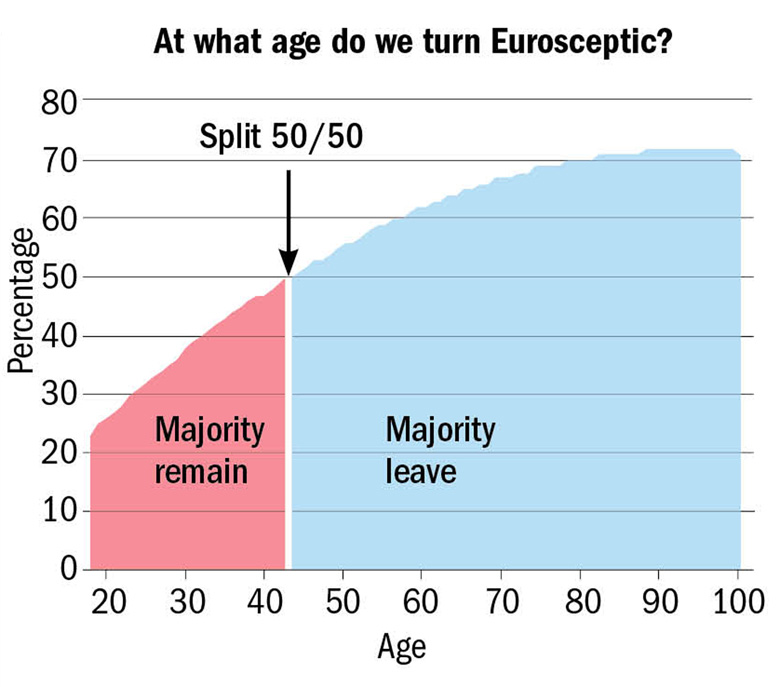If a picture’s worth a thousand words, what value should we put on a particularly good graph?
Thinking back over the months (or has it been years?) of debate about whether or not Britain should stay in the European Union, two graphs stick in the mind more than any soundbite.
The first, based on polling by YouGov in April, shows the startling correlation between age and the likelihood that you’ll back Brexit.
It pinpoints a precise tipping point: if you’re over 43 you’re more likely to be in favour of leaving; if you’re under 43 then most want to stay put.
This will be a bit discombobulating for many academics who have crossed this particular Rubicon. As Stephen Curry, professor of structural biology at Imperial College London, put it in a tweet: “It’s official. At 52, I am finally a rebel. #StrongerIn.”

But it underlines the importance to the Remain cause of younger voters turning out on 23 June, and the role that universities can play by getting students to register (a far more significant intervention than preaching to the converted in open letters to The Times, one suspects).
The second particularly striking graph draws on work by Alan Renwick, deputy director of the Constitution Unit at University College London, and addresses how opinion is likely to shift in the last month of the campaign.
By reviewing the evidence from more than 30 previous referendums around the world, the graph (and I’m quoting here from an excellent presentation by Rob Ford, professor of political science at the University of Manchester) shows that it is much more common for there to be a shift towards the status quo now that we’re in the final straight.
As Ford put it, the median voter is risk-averse and when it comes to putting an X in a box, many decide that it’s not worth the gamble of voting for change. He also pointed out in his talk at a Higher Education Policy Institute seminar earlier this year that in 13 out of 17 recent or relevant referendum campaigns, the final polls underestimated the level of support for the “status quo” (including in the Scottish independence vote).
The only occasions when the polls underestimated support for the “change” option were when this side of the argument already had a strong lead.
All of which seems to be reassuring for those in higher education – or, indeed, elsewhere – who are in favour of staying in the EU.
And if you’re undecided, or just want to revel or wallow in the arguments one last time (OK, it won’t quite be the last time), then turn to our cover story to read Brexit and Bremain perspectives from seven scholars. You’ll find more of the latter than the former – only one contributor argues for leave, but that’s probably a fair reflection of sentiment across academia (we’ll have a better picture of this next week, when we publish the results of our Brexit poll). Some of those arguing to remain are even over the age of 43.
POSTSCRIPT:
Print headline: Valuable insights in the arcs
Register to continue
Why register?
- Registration is free and only takes a moment
- Once registered, you can read 3 articles a month
- Sign up for our newsletter
Subscribe
Or subscribe for unlimited access to:
- Unlimited access to news, views, insights & reviews
- Digital editions
- Digital access to THE’s university and college rankings analysis
Already registered or a current subscriber?



